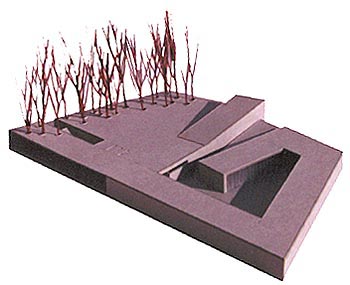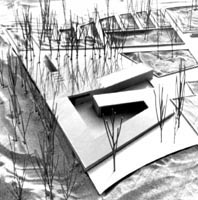¿Cómo un OBJETO pasa de ser el paseo de un bello jardín
a introducirse bajo tierra?, ¿Cómo se sumerge bajo un lago?, ¿Cómo
consigue luz?, ¿Cómo se transforma en PAISAJE sin dejar de ser
reconocible?
Una pieza de hormigón se desdobla para ofrecer una
entrada, se deforma para salvar los árboles, se amolda a los desniveles
del terreno, para luego emerger del lago y remarcar finalmente la entrada.
Este elemento continuo sintetiza las distintas sugerencias
que nos transmite el lugar, y sin dejar de perder su identidad, pasa a
formar parte de su memoria.
50 cms, una línea de suelo que acompaña al caminante, un
largo banco donde descansar, un muro casi imperceptible, la única
presencia de este edificio enterrado.
Bajo el mar de pinos, bajo el estanque de nenúfares, un
secreto escondido.
Un edificio casi mudo que no puede evitar emerger para
mostrar el camino, una invitación para descubrirlo.




